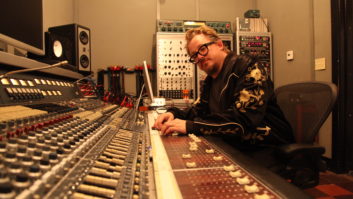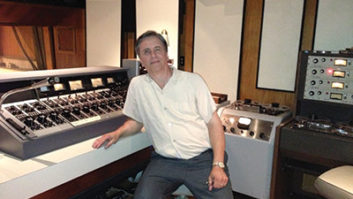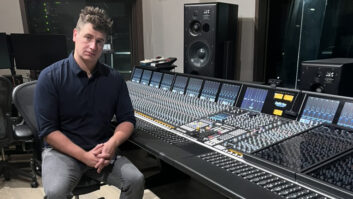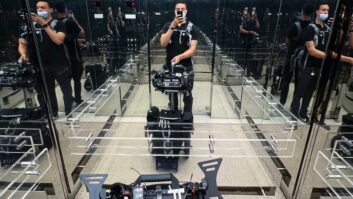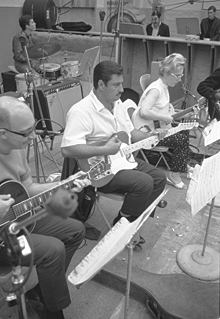
Tommy Tedesco and Carol Kaye in session, mid-’60s
Denny Tedesco says that the decision to make his extraordinary new documentary, The Wrecking Crew — about the L.A. session musicians who played (anonymously) on a zillion hits through the ’60s — was prompted by the revelation in the mid-’90s that his father, legendary studio guitarist Tommy Tedesco, had been diagnosed with cancer. “When that happened, I thought, ‘Okay, I’ve gotta do this now,’” Denny Tedesco says.
But “now” can take a long time in the world of independent documentary filmmaking. Thirteen years after Tedesco started work on this dream project, The Wrecking Crew has won awards and critical plaudits at film festivals worldwide, yet as of early October, it still doesn’t have a U.S. distributor in place, nor a deal to eventually release the film on DVD, where it will be a sure-fire winner.
Tedesco, who these days works mainly as a commercial producer but has a long history in various capacities in film, says that The Wrecking Crew project began humbly: “Once I decided to do it, I got a couple of 16mm cameras, I put together a small crew of friends and we shot four players from the Wrecking Crew — my father, [bassist] Carol Kaye, [drummer] Hal Blaine and [saxophonist] Plas Johnson — sitting at a round table telling stories. That was our first day of shooting. It came out really well because it sort of felt like they’d just put down their instruments for a few minutes and were talking informally, teasing each other and laughing; they’re like a quartet. It was very warm.”
Next, Tedesco managed to snag interviews with a few “names” who had been associated with the Wrecking Crew at one time or another, including Cher (who worked as a backup singer on Wrecking Crew dates before she hit the big time and the musicians backed her on Sonny & Cher records), Dick Clark and Nancy Sinatra (who was backed by the Crew on her biggest hit, “These Boots Are Made for Walkin’,” as well as the Number One smash she recorded with her father, “Jackson”). In hopes of attracting some financing, Tedesco put together a 14-minute reel from those interview sessions, and while it didn’t exactly open the money floodgates (he ended up mostly self-financing the project), it did open the doors to further work on the film, and in the end nearly everyone he approached to become involved with The Wrecking Crew agreed to do it. Now, scattered across the 90-minute film, which was expertly edited by Claire Scanlon, are interviews with Brian Wilson (the Wrecking Crew played on some of the Beach Boys’ best albums), Herb Alpert (Tijuana Brass), Glen Campbell (a Crew guitarist before becoming a popular solo artist backed by the group), songwriter Jimmy Webb, engineers Bones Howe and Larry Levine, and many others. The creative use of stock footage from the ’60s and a slew of great photographs of the musicians at work at various studios around town (there is almost no existing film footage of the Crew in action) help place the story in a lively historical context.
The film notes that the Wrecking Crew — a sobriquet they were given years after their heyday — was not a fixed group of players, but rather an amorphous collection of a couple dozen studio pros who, over the years, became the first-call players on a staggering number of records made in L.A. There were several different drummers, guitarists, bassists, keyboardists and horn players who could rightfully claim to be part of the Wrecking Crew’s proud legacy, and Tedesco is careful to shine the light on many of them (and list all of them in the credits). At the same time, he uses the stories of his original foursome — Tommy Tedesco, Carol Kaye, Hal Blaine and Plas Johnson — to tell the saga of what life was like for hard-working studio cats in that exciting era. We hear in detail what went into Phil Spector’s Wall of Sound and Brian Wilson’s fabulously eccentric productions. We see Carol Kaye demonstrating the unusual bass line she created for “Good Vibrations,” and later sit in with Joe Osborn as he plucks the sinewy bass part for the Fifth Dimension’s “Aquarius.” There’s lots of “inside” stuff like that throughout the film, but it’s never boring or pedantic.
Of course, at the heart of The Wrecking Crew is the music, and obtaining the rights for 131 cues was no easy task. “That definitely was the biggest struggle,” Tedesco says. “Everyone said, ‘It’s not going to happen; it’s impossible.’ Because if you licensed these songs for a regular feature film, it would be prohibitive. People said, ‘Why don’t you get it down to 20 songs?’ And I said, ‘You can’t. The whole point is how much they did, from Sinatra to The Chipmunks to The Mamas & The Papas to the Beach Boys, and so on. They went from date to date to date for years and I wanted the music to be wall to wall, no pun intended.
“Once I got a cut together, if there was a problem with someone not wanting to sign off, I might make a QuickTime of that scene and send it off to whoever the publisher was, and say, ‘C’mon, help me out! Please!’ ‘All right, fine.’
“In the end, I was very fortunate. It took a lot of work, but almost everyone came through. If it wasn’t for the record companies and publishers coming together, this never would have happened.”
For more, check out
www.wreckingcrew.tv.
